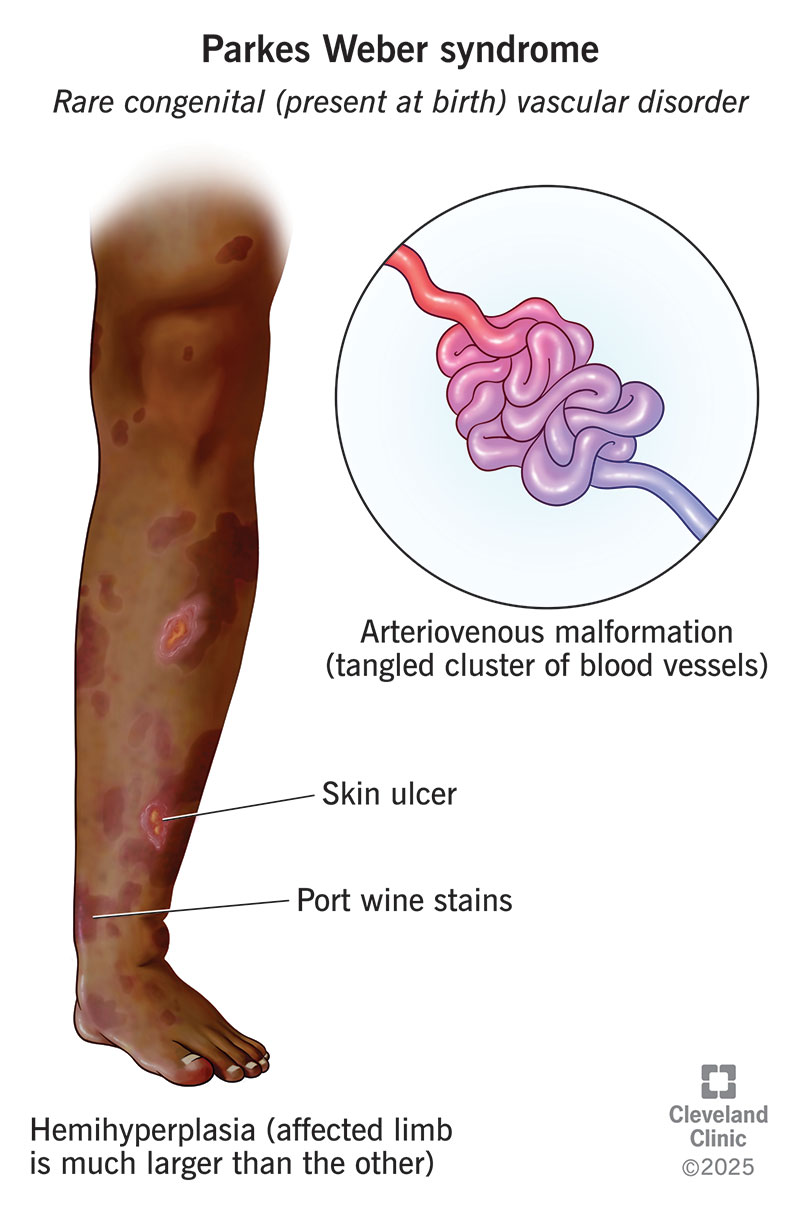Parkes Weber syndrome is a rare vascular disorder that’s present at birth. A tangled cluster of irregular blood vessels is the main issue, but people also have port wine stains and one limb that’s larger than the other. Treatments of various kinds help with symptoms and slowing down the disease. A few complications can be life-threatening.
Advertisement
Cleveland Clinic is a non-profit academic medical center. Advertising on our site helps support our mission. We do not endorse non-Cleveland Clinic products or services. Policy

Parkes Weber syndrome is a rare congenital (present at birth) vascular disorder. It involves a tangled network of irregular blood vessels. In diagnostic images, the cluster of tangled blood vessels looks like a tumbleweed. This blood vessel cluster has a hard time circulating blood to areas that rely on it for their blood (and oxygen) supply.
Advertisement
Cleveland Clinic is a non-profit academic medical center. Advertising on our site helps support our mission. We do not endorse non-Cleveland Clinic products or services. Policy
This syndrome typically affects only one limb (usually one leg). This limb may develop skin ulcers (open sores) from a lack of oxygen. This type of wound is hard to heal due to a lack of blood supply.
Complications of Parkes Weber syndrome can be life-threatening. But regular monitoring helps catch issues that develop over time. Providers have many treatments they can use to help ease symptoms and slow the disease down.
Parkes Weber syndrome symptoms and signs may show up at birth or during childhood. Symptoms include pain, swelling and fatigue in the affected area, usually in one leg.
Signs of Parkes Weber syndrome include:
This condition is like Klippel-Trenaunay syndrome, which has venous malformations and purple port wine stains.
A variation in your RASA1 gene can cause Parkes Weber syndrome. This gene plays a role in how your vascular system develops. You may inherit this variation from one biological parent. But it can also happen at random (without a biological family history).
Advertisement
High-output heart failure is a serious complication of this condition. This can lead to an enlarged heart and pulmonary edema (fluid buildup in your lungs). Skin infections from skin ulceration are common and require treatment.
Other complications may include:
It may be difficult to get a Parkes Weber syndrome diagnosis because the condition is rare. But a provider may suspect your child has it based on what they see in a physical exam. A provider may talk about different syndrome stages, from I to IV. Stage I usually doesn’t have symptoms. Stages II through IV include symptoms, with IV being the worst.
Tests to diagnose Parkes Weber syndrome may include:
Providers don’t have a cure for Parkes Weber syndrome. But treatments can ease symptoms and keep the syndrome from getting worse. Parkes Weber syndrome treatment varies from person to person. Treatments range from simple, noninvasive measures to procedures that destroy blood vessels.
Treatments may include:
Parkes Weber syndrome is a chronic (long-term) condition. Vascular malformations tend to become more noticeable over time. And your child may develop more port wine stains as they age.
Some people need a hospital stay to treat bleeding or infected ulcers.
Embolization and other treatments can improve circulation. But your child will most likely need treatment more than once for an AVM. This is a condition that requires lifelong follow-ups.
Because the disease is rare, information about a Parkes Weber syndrome prognosis is limited. One study included a few people who had their first treatment in their 40s and even late 60s. Most of the others in that study had their first treatments before age 17. This suggests that most people need treatment during childhood.
Advertisement
Because this syndrome is present at birth, you can’t prevent it. You can talk with a genetic counselor if Parkes Weber syndrome runs in your family and you’re planning a pregnancy. But the syndrome can happen even if you don’t have a biological family history of it.
Having a child with Parkes Weber syndrome means being extra observant. In addition to watching for typical childhood illnesses, it’s important to keep an eye out for signs that the syndrome is getting worse. Your child’s healthcare providers can help you monitor any changes in their condition.
Helping your child stay at a weight that’s healthy for them may help with their symptoms, as well.
The short answer is: regularly. A team that specializes in vascular issues may be the best bet for your child. You’ll likely need to take your child to regular checkups with several providers, like a:
Your child may have regular tests like echocardiograms or MRIs to check for complications. They should see their provider whenever they have painful swelling in the affected area.
Seek immediate treatment for your child if they’re having:
Advertisement
Questions to consider asking your child’s provider may include:
It may be a relief to get a diagnosis, especially if you’ve seen multiple providers. But learning that your child has Parkes Weber syndrome can be overwhelming. The good news is that many treatments are available. A team of vascular experts and related providers may be your best option. They’ve likely seen a number of cases of this rare syndrome.
Advertisement
Vascular disease may affect your life in big and small ways. Cleveland Clinic’s specialists treat the many types of vascular disease so you can focus on living.

Last reviewed on 08/11/2025.
Learn more about the Health Library and our editorial process.